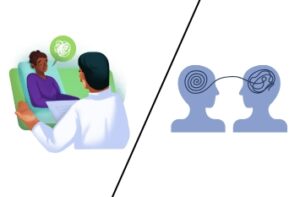
Counseling vs. Therapy: What’s the Difference, and Which One Do You Need?
Counseling vs. Therapy: What’s the Difference, and Which One Do You Need? When You’re Ready to Seek Support When you’re ready to seek support for

First-generation antipsychotics, also known as typical antipsychotics, have been a cornerstone in the treatment of serious mental health conditions for decades. Developed in the mid-20th century, these medications are designed to manage symptoms such as hallucinations and delusions, primarily by blocking dopamine receptors in the brain.
Though newer medications have emerged, first-generation antipsychotics remain crucial for many patients due to their effectiveness and established track record. Understanding their role, benefits, and potential side effects is essential for anyone navigating the complexities of mental health treatment.
Whether you are a patient, caregiver, or healthcare provider, gaining insights into these medications can help you make informed decisions and optimize treatment outcomes.
First-generation antipsychotics, also known as typical antipsychotics, are a class of medications that have been used since the 1950s to treat severe mental health conditions such as schizophrenia and bipolar disorder.
These drugs were pioneering in their time and marked a significant advancement in psychiatric medicine. They are distinguished from newer antipsychotic drugs by their specific clinical profile and side effect profile.
While modern treatments offer alternative options, first-generation antipsychotics continue to be an important part of mental health care due to their established effectiveness and long history of use in managing acute psychotic episodes.
First-generation antipsychotics, also known as typical antipsychotics, play a critical role in managing symptoms of schizophrenia and psychosis by targeting specific brain chemicals. These medications primarily work by inhibiting dopamine activity, a neurotransmitter involved in pleasure, mood, learning, and memory. By blocking D2 dopamine receptors, these drugs reduce excessive dopamine activity that contributes to psychotic symptoms.
Additionally, some first-generation antipsychotics also affect other neurotransmitters like norepinephrine and acetylcholine, and in some cases, like with loxapine, they can also impact serotonin receptors to help manage mood and aggression.
When exploring the first-generation antipsychotics list, several medications stand out for their role in managing severe mental health conditions. These drugs have been in use for decades, and each has its unique profile in treating psychotic disorders. Below are some of the most commonly prescribed first-generation antipsychotics:
These medications represent a diverse array of options within the first-generation antipsychotics list, each with specific applications and benefits.
First-generation antipsychotics offer several benefits in the treatment of severe mental health conditions, particularly schizophrenia and psychosis. These medications are well-established and have a long history of effectiveness in managing acute psychotic episodes and alleviating symptoms such as hallucinations and delusions.
One significant advantage is their strong track record of efficacy, as these drugs have been used successfully for decades. They are often more affordable compared to newer antipsychotics, making them accessible to a broader range of patients.
Additionally, the availability of various formulations, including both oral and long-acting injectable forms, provides flexibility in treatment plans. Despite their side effect profile, these medications remain a valuable option in psychiatric care due to their proven benefits in stabilizing symptoms and improving patient outcomes.
While first-generation antipsychotics are effective in treating severe mental health conditions, they are not without potential side effects and risks. These medications can lead to a range of adverse effects, particularly related to motor control, such as tremors, rigidity, and tardive dyskinesia, a condition characterized by involuntary movements.
Side Effect/Risk | Description |
Extrapyramidal Symptoms | Motor control issues like tremors, rigidity, and bradykinesia. |
Tardive Dyskinesia | Involuntary movements, often occurring with long-term use. |
Sedation | Drowsiness and decreased alertness. |
Weight Gain | Potential for significant weight increase. |
Dry Mouth | Reduced saliva production leading to discomfort. |
Metabolic Disorders | Risk of developing conditions like diabetes and high cholesterol. |
Cardiovascular Issues | Potential for increased risk of heart-related problems. |
When comparing first-generation and second-generation antipsychotics, key differences emerge in terms of efficacy, side effects, and overall patient experience. First-generation antipsychotics, also known as typical antipsychotics, are well-established and effective at managing acute psychotic symptoms but are often associated with more pronounced motor control side effects and other adverse reactions.
In contrast, second-generation antipsychotics, or atypical antipsychotics, offer a broader range of benefits, including reduced risk of motor control issues and potentially fewer side effects related to movement disorders. However, second-generation antipsychotics can sometimes lead to metabolic side effects such as weight gain and diabetes.
The choice between these two classes of medications depends on individual patient needs, response to treatment, and tolerance of side effects.
Aspect | First Generation Antipsychotics | Second Generation Antipsychotics |
Efficacy | Effective for managing acute psychotic symptoms. | Generally effective for a wider range of symptoms. |
Side Effects | Higher risk of extrapyramidal symptoms and tardive dyskinesia. | Lower risk of motor control issues, but can cause metabolic side effects. |
Examples | Haloperidol, Chlorpromazine, Loxapine. | Risperidone, Olanzapine, Quetiapine. |
Metabolic Effects | Less commonly associated with metabolic disorders. | Higher risk of weight gain, diabetes, and hyperlipidemia. |
Treatment Flexibility | Well-established but with fewer options for management. | Greater flexibility with various formulations and dosing options. |
Cost | Generally less expensive. | Often more expensive but with additional benefits in terms of side effect profile. |
Research into antipsychotic medications is continually evolving, with ongoing studies aimed at improving the efficacy and safety of these treatments. Recent advancements focus on understanding the underlying mechanisms of first-generation antipsychotics to minimize their side effects and enhance their therapeutic benefits.
Researchers are exploring novel formulations and delivery methods to address issues such as adherence and long-term management. Additionally, studies are investigating ways to manage better the adverse effects associated with these medications, including motor control disorders and metabolic issues.
Future directions in first-generation antipsychotic treatment may involve developing new compounds with improved profiles, integrating personalized medicine approaches to tailor treatments more effectively, and exploring combination therapies to optimize patient outcomes.
First generation antipsychotics have played a foundational role in the treatment of severe mental health disorders for decades. Despite the emergence of newer medications, these classic drugs continue to offer significant benefits in managing symptoms of schizophrenia and psychosis. Understanding their mechanisms, benefits, and potential side effects is crucial for effective treatment.
As research progresses, ongoing advancements aim to enhance their efficacy and reduce adverse effects, ensuring that first generation antipsychotics remain a valuable component of psychiatric care

Counseling vs. Therapy: What’s the Difference, and Which One Do You Need? When You’re Ready to Seek Support When you’re ready to seek support for
